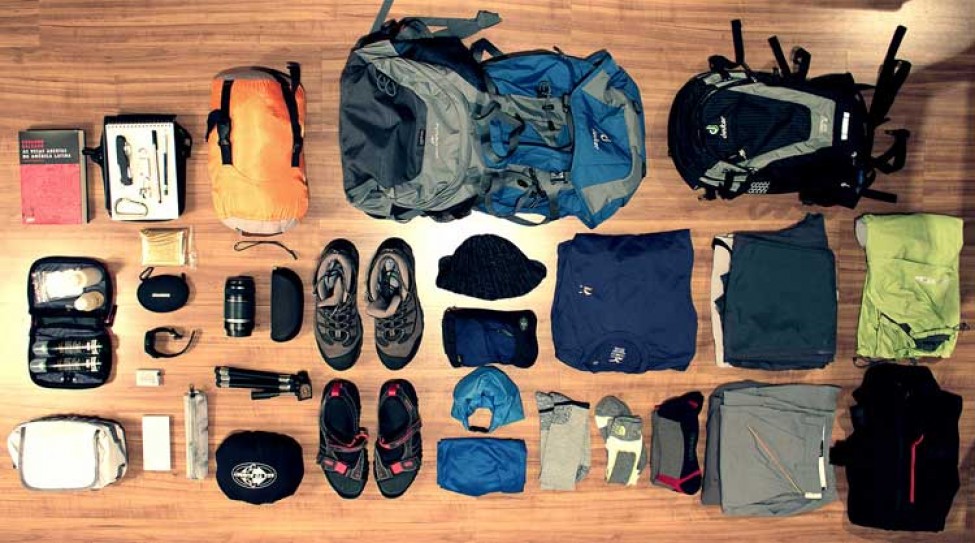The Season has been began of wanderlust all around the world. Travellers from everywhere are planning to explore new places and have an experience that could only be described as an epic. Trekking is one of the most common adventure trip and gateway. If the travel bug bites you this season and you plan a trip along with your gang then Switch 2 Travel has brought you some trekking essential for you.
The Bag packs and Bags


Before anything else, Lets talk about trekking bags. Depending on the duration of trek 45-55 liter backpack would be sufficient to carry all your essentials. In mountains you never know if its going to rain or snow so prepare for the worst conditions and carry waterproof bag cover.
Cloths and Shoes


If it is about Clothing then you must carry, few quick-dry t-shirts (both long and short sleeved), a fleece jacket and wind-cheater; waterproof outer jackets and pants, a pair of comfortable but rugged pants (with pockets); thermal underwear, 3 pairs of warm socks, a few scarves, and regular underwear. Of course, you can tweak this based on the weather and temperature of your destination.
For shoes, A solid pair of comfortable ankle-length water proof trekking shoes will help to prevent your ankles from getting twisted. So good trekking shoes will be your life saviour during the trek. Also make sure to carry Flop-Flops you can use them at the end of long day when you give your feet rest.
The Other Hiking Essentials


Apart from your medicines, clothes, and food, there are many other things you should carry with you. You’ll need a torch in the dark, whether you’re still walking or walking around your camp. It’s always good to carry a quick-drying towel, even if you won’t be able to take a proper bath on the trek. Also, carry a walking stick to help in downhill sections.
A reusable water bottle is also absolutely essential. You can keep refilling it along the way and reduce your plastic waste. Equally essential is sunscreen, lip balm, moisturizer, a hat, and sunglasses. The higher up you go, the more powerful the sun’s rays. Colder temperatures and arid conditions can also dry out your skin causing it to painfully crack.
The Medicine and Food


You may not have experienced high-altitude sickness in other trips to the mountains, but every trek is different. They drain your energy with every step you take, be it uphill or downhill. So, it’s better to be prepared for the worst than be unprepared thinking about just the best. Other than medicines for high-altitude sickness, make sure to carry medication for cold, constipation, headache, fever, band-aids, painkillers, basic antibiotics, and specific medication for any condition that you may have. You should also carry toilet paper, toothbrushes and paste, hand sanitizer, pads/tampons, and soap.
As far as food is concerned, your guides should have the cooking essentials with them (unless it’s a private trek). But, even if your meals are provided for you, it’s good to have some snacks to eat between meals. Nuts, dry fruits, high-calorie energy bars, chocolates, biscuits, cookies, and peanut butter are all good to quench lingering hunger pangs. You will also need to carry your own mug and bowl or plate.
Pack Wisely


Lastly, but very importantly, pack wisely. If it’s something that you think you MAY NOT need, it shouldn’t make it to your backpack. Remember, you’ll have to quite literally carry the weight of your own wrong decisions, as these unnecessary things will only add to the weight on your shoulders and not have any utility.
You should also ensure that you have a fully charged phone and if you’re planning to take lots of pictures, a separate camera so that you don’t drain its battery. It’s usually best to assume that you won’t find electricity on your trekking route. So, carry extra batteries, solar powered or portable chargers, as well as the necessary cables.
Here’s a trek packing checklist for those too lazy to read
- A good backpack: Sturdy, durable, easy weight distribution and comfy shoulder pads/straps
- A detachable day pack
- Waterproof cover
- Good quality tent (preferably with a mosquito lining) – if you are camping alone, group treks usually provide tents
- A sleeping bag that can endure temperatures under -10°C
- Insect repellant
- Medicines
- For cold and fever
- Constipation/diarrhoea/nausea
- Painkillers
- Band-aids
- Antiseptic
- Bandages/gauze
- A small pair of scissors
- Thread and needle
- Cotton
- Personal medication for any pre-existing conditions
- Antibiotics
- Toiletries
- Hand wash/soap
- Facewash
- Feminine hygiene products/men’s self-care products
- Sanitizer
- Toothbrush and paste, mouthwash
- Comb/hairbrush
- Toilet paper/wet wipes
- Sunscreen
- Lip balm
- Moisturiser
- Snacks
- High energy protein bars
- Dry fruits and nuts
- Biscuits and chocolates
- If trekking by yourself then also take easy-to-make or ready-to-eat foods like noodle packets, bread and peanut butter, etc
- Utensils, one each of:
- Plate
- Spoon and Fork
- Mug
- Bowl
- If trekking by yourself also carry basic cooking utensils like one or two multi-purpose pans. Stores like Decathlon will have specific camping utensils that are easy to pack as well.
- Clothes – tweak this based on weather, temperature and duration of the trek
- Few quick dry t-shirts (long sleeved and short sleeved)
- Fleece jacket and windcheater
- Waterproof jacket and pants
- Comfortable trekking pants
- Thermal underwear
- Pairs of warm socks (3)
- A pair of gloves
- Scarves
- Woollen hat and sun cap
- Underwear
- Quick-dry towel
- Sturdy trekking shoes + a pair of slip-ons or flip flops
- Water bottle + water purification tablets (or a water bottle that filters water)
- Torch
- Camera
- Extra batteries for all electronic equipment
- Power bank or solar powered reusable batteries
- Sunglasses
- Any necessary documents and photo IDs


Comment (0)